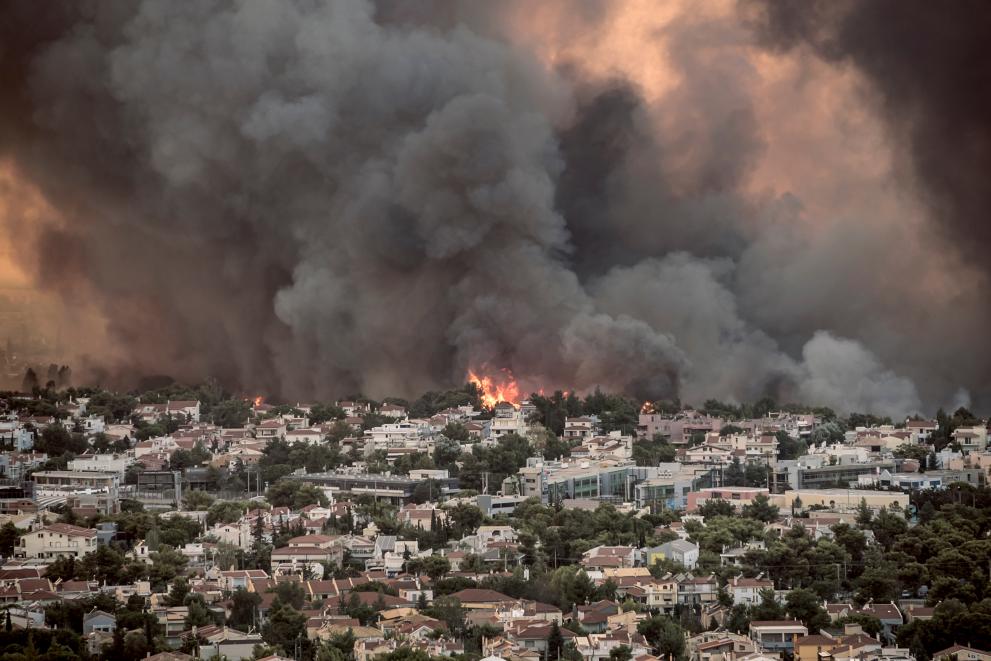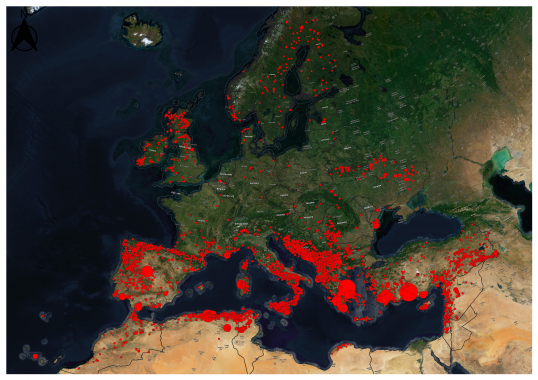
2021 was the second-worst wildfire season in the European Union since 2000, when the European Forest Fire Information System EFFIS records began. Damages in 2021 were only surpassed by those in 2017, when over 1 million hectares (ha) burned in the EU. The report finds that large and extreme fires affected many countries, especially in the Mediterranean Basin and warns about the current dangerous conditions that can fuel wildfires.
In 2021, fires were observed in 39 countries, burning 1 113 464 ha as mapped by the European Commission’s Joint Research Centre (JRC). Turkey was most affected by wildfires in 2021, which alone accounted for 206 013 ha burnt from a large number of massive fires. It was followed by Italy, with 159 537 ha and a record of 1422 fires mapped in EFFIS – nearly four times the average of the last 13 years – and Algeria with 134 273 ha.
Also in 2021, the most affected individual land cover type was agriculture with 25%; however, different categories of forests together accounted for 28% of the total burnt area. Other natural land types accounted for the remaining land cover burnt.
European Union countries
EFFIS mapped fires in 22 EU27 Member States in 2021 – except for Czechia, Estonia, Luxembourg, Malta and the Netherlands – which resulted in a total burnt area of 500 566 ha in the EU. August was the month during which a significant proportion of the damage occurred, particularly in Greece. Of this total, half a million hectares, 20% of the total, occurred on ‘Natura 2000’ sites.
Natura 2000 protected areas
As in previous years, fires hit Natura 2000 sites hard. The total burnt surface in these protected areas in 2021 reached 102 598 ha, less than in the two previous years and slightly below the average of the last 10 years. In terms of damage to Natura 2000 sites, the most affected country in 2021 was Italy, followed closely by Spain. Together, the two countries account for 45% of the total burnt area in Natura 2000 sites. The analysis of the damage caused by fires to these protected areas within the Natura 2000 network is of particular concern, as they include the habitats of special interest and home to endangered plant and animal species.
The 2022 fire season
The report also looks at the situation in 2022 and the growing issue of forest fires in the EU. Some of the 2022 fire season’s main findings are that it started with a prolonged drought in southern Europe, and the resulting conditions have already caused numerous premature fire outbreaks.
The impacts of climate change are becoming more evident each year. Wildfires are more frequent and extreme, as also confirmed by the recent report of the International Panel on Climate Change (IPCC) “Climate Change 2022: Impacts, adaptation and vulnerability” and the recent United Nations Environment Program report “Spreading like wildfire: The rising threat of extraordinary landscape fires.”
The JRC therefore continues to monitor wildfires and provide early alerts of wildfire danger, while the European Commission stands ready to support Member States and neighbouring countries to tackle wildfires in 2022 and beyond, with increased capacity in the context of the EU Civil Protection Mechanism (UCPM).
In 2021, the European Commission responded to nine requests for assistance through the UCPM. Within less than two weeks in August, aerial and ground forest firefighting capacities were mobilized to support six operations in Turkey, Italy, Albania, North Macedonia, Greece and Algeria.
Background
The Joint Research Centre provides a pivotal contribution to wildfire disaster risk reduction in Europe and globally through the development and operation of the European Forest Fire Information System (EFFIS). Under the EU Copernicus program and the Expert Group on Forest Fires (EGFF), EFFIS provides continuous monitoring from satellites of the fire situation in Europe and the Mediterranean area supporting civil protection operations in the framework of the EU Civil Protection Mechanism (UCPM).
The Forest Fires in Europe, Middle East and North Africa reports of the JRC provide a comprehensive overview of forest fires. The 2020 edition included reports from 33 countries in the covered regions describing national fire management activities and actions taken at both national and European levels during the fire campaigns in this period.
The current JRC Advance EFFIS Report on Forest Fires in Europe, Middle East and North Africa 2021 is a preliminary report on the 2021 fire campaign. A comprehensive study is done periodically at the end of each fire season. As in previous years, the JRC will publish the full Forest Fires in Europe, Middle East and North Africa 2021 in autumn this year, including the reports from the countries in the region analysed.
Sources
Details
- Publication date
- 21 March 2022
- Author
- Joint Research Centre

